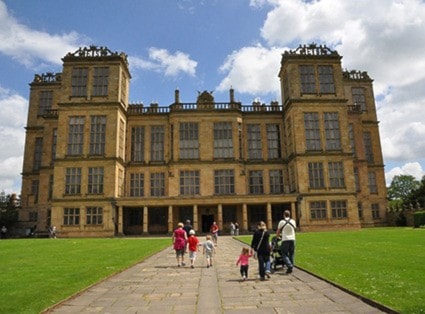For the next seven months British royalty will, no doubt, trend on Twitter while media madness reigns over the sex of the succession to the throne plus all other related minutia.
Stuck in the middle, the young Duke and Duchess of Cambridge will, presumably, direct their attention to focusing on pregnancy and privacy.
The betting shops are already in full swing. I don’t have any hot tips on the usual line-up of names, but for what it’s worth – I’m putting a pound on Alexandra. Yep. My money’s on a princess for Will and Kate.
Why?
Perhaps, I am influenced by a summer visit to Derbyshire’s Hardwick Hall, a stately home that firmly reminded me that no matter what the pomp and circumstance, Britain’s aristocratic gals once rarely took a backseat to anyone.
In 1539, 12-year-old Elizabeth (Bess) Hardwick, the fourth daughter of a gentleman farmer, was sent to live at Codnor Castle for “gentlefolk training”. She wasn’t stony broke, but, like all young women of her era, a suitable marriage was a key career move.
Within the year, she had nursed the ailing Robert Barlow, captured his heart, and married him. Both were the ripe old age of 13. But Robert, who didn’t last long, passed away leaving her a third of his wealth – the princely sum of £8 - as the laws of the day decreed.
“This situation led her back to the household of the Greys,” my Hardwick guide, Jim Munro, tells me. “Here, as a 17-year-old gentlewoman companion with a new widowhood status beyond her years, she met Lady Jane Grey, now known as the 9-day Queen, and the teenaged Princess Elizabeth, whom she befriended and remained friends with for life.”
A second marriage, to Sir William Cavendish, 22 years her senior, produced eight children (six of whom survived), a practical education in accounting and estate management, and substantial wealth, before he departed for the great beyond in 1557.
By this time, she was well on her way up the court social ladder. Her appointment as lady-in-waiting to Queen Elizabeth 1 lead her to Sir William St. Loe, a marriage in 1559, and, eventually, after his death, to a £13.8 million (in today’s terms) inheritance to swell her already substantial coffers. Not too shabby for a farmer’s daughter, who, you can bet, was paying attention, and wisely choosing where to flutter her fan and bat her eyes.
Still in her 30s, and despite surviving a stint in Tower of London for upsetting Elizabeth, she was elevated to a Lady of the Bedchamber and finally married George Talbot, sixth Earl of Shrewsbury.
In an era when heads rolled, and sentiment was in short supply, Bess kept everything intact – especially the cash and enough real estate to make her the second wealthiest woman in England, after the Queen.
I am awed by this woman’s entrepreneurial acumen as Jim Munro, one of Hardwick Hall’s many excellent tour guides, gave me the detailed low-down on the imposing Elizabethan estate dominating a hillside overlooking Mansfield and Chesterfield.
Other properties in Bess’ impressive portfolio include the elegant Chatsworth House (still home to the Duke and Duchess of Devonshire), and the 12th century classic Bolsover Castle. She certainly had good taste.
Jim, a retired Nottinghamshire history master, happens to be my cousin who delights in volunteering at Hardwick.
He tells me that the stunning array of enormous windows indicated wealth. “Bess’s windows at Hardwick were a pure show of status … she owned the glass and lead works anyway.” She designed Hardwick, and the windows earned the house the tagline, “Hardwick Hall, more was glass than wall”.
The famous Hardwick Hall textiles – an intriguing 400-year-old collection including tapestry, embroidery, and canvas work – is the world’s largest single private family collection of such crafts. Bess herself worked on many, including the famous Oxburgh Hangings, with Mary Queen of Scots, whom she “hosted” at Chatsworth at different times before Mary’s execution.
Despite all the windows, some of the massive rooms are dark, a blessing for preserving textiles and art works.
The grounds of the house are lush, rolling, nicely treed, and home to assorted farm animals.
Young families enjoy picnicking in the grounds, and the steady stream of visitors inevitably wend their way to the tearoom.
We opted for the Hardwick Inn in Chesterfield, a pretty spot with a reasonably priced pub menu and good service.
Looking back, as we drive away, Bess’s presence is still felt with her initials EH clearly carved into the Hall towers.
We decide our tour would not be complete without a visit to Derby Cathedral where Bess, also known as Bess the Builder, is interred. Surrounded by alabaster, she designed her own final resting place – which included space for 47 of her relatives.
Her one unfulfilled ambition was to see her granddaughter, Arbella become Queen. The bloodline, does, however, extend to the current royal family, which makes one wonder how much next year’s royal baby will inherit of her ancestor’s entrepreneurial gumption. In a different way, I’m guessing “she”, if my bet delivers, will need every ounce of it. As, Will and Kate know, the court of 21st century public opinion is tougher in many ways than the 12th century one Bess navigated.
This royal child will need all the good genes it can muster, even with wealth.
For more information on Bess of Hardwick (Countess of Shrewsbury) and her homes, go to:
www.nationaltrust.org.uk/hardwick
www.english-heritage.org.uk/daysout/properties/bolsover-castle
